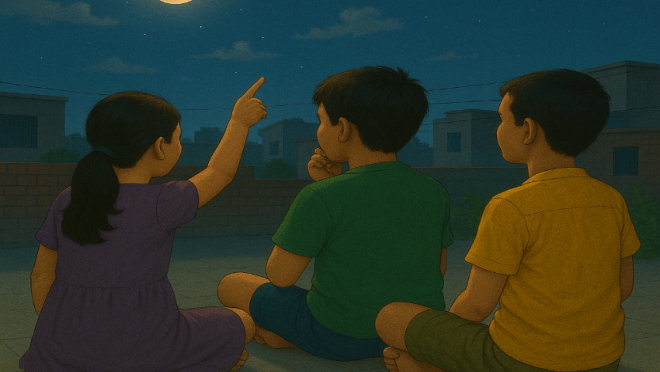POV: Can you see what I see?
POV: Can you see what I see?

Before smartphones illuminated our palms and Netflix became our evening companion, there was a different kind of magic that sparked during load shedding. It needed no Wi-Fi or mobile data—only your vision and imagination. And for many 90s kids, growing up in Bangladesh (or South Asia at large), that magic took the shape of a simple yet enchanting game: “Can you see what I see? (Ami ja dekhi tumi ki ta dekho?)”
For those unfamiliar with the game, its rules are deceptively simple. Two or more participants gather—perhaps on a rooftop under the open sky, beside the gentle glow of candlelight, or seated on a quiet verandah during a power cut.
One individual selects an object—either visible or imagined—and poses a gentle yet intriguing question to the others: “Can you see what I see?” The speaker then offers subtle clues to guide the others toward the answer. The remaining players try to discern what the speaker has in mind. It could be a colour, a shape, a distant star shimmering in the darkness, or the shadow of a tree swaying on the wall.
At times, it may be something entirely imaginary—a cloud shaped like a dragon, a moon that seems to conceal a hidden face, or a star that sparks the illusion of a distant spacecraft. The beauty of the game lies in its ability to awaken creativity and invite participants to perceive the world through another’s perspective.
We are living in a world where the vast majority of the people are judgemental, and they practice toxicity by nourishing only their beliefs, thoughts, and feelings. They do not want to view the world through someone else’s lens. As a result, they always spread irrelevant, hateful, and even misogynistic comments, be that on online platforms or in real-life conversations. These people reflect a lack of understanding, acceptance, and appreciation for others’ sentiments and points of view.
Let’s explore some real-life scenarios of how POV can vary. For example, one person might stand at the edge of the sea and feel a sense of serenity—as if the waves are murmuring peace, offering space to breathe, to let go, and to try again. For someone else, those same waves might awaken something heavy—a memory of a traumatic journey, a loved one lost at sea, or the ache of someone who never came back. The waves remain the same, yet the meaning they carry shifts with the beholder.
Again, a busy city street can feel alive and inspiring to one person through its diversity, pace, and possibility. To another, it may feel crowded and exhausting, a place where it’s easy to feel lost, isolated and depressed. The same environment can either uplift or drain, depending on one’s internal state and past experiences.
Similarly, a student may see a classroom as a place of opportunity and growth, filled with chances to explore and question. Another may experience it as a space of pressure, anxiety, or exclusion. The same lesson is taught, the same walls surround them, yet the emotional landscape is entirely different. Such contrasts do not invalidate one another; instead, they reveal the layered nature of perception. They show us how deeply personal the world becomes when filtered through our own stories — one horizon, infinite meanings.
Coming back to the game, “Can you see what I see?” quietly manifests this very idea—that every two people do not see the world the same way. To ask, “Can you see what I see?” is not necessarily to demand agreement or validation.
Instead, it serves as an invitation—to pause, to imagine, to observe more closely, and to engage with the world through another’s lens, if only for a moment. Through playful guessing and gentle clues, it encourages dialogue, fosters empathy, and reminds us that beneath every visible surface lies a deeper narrative. What seems like a simple childhood pastime is, in truth, a small but powerful lesson in nurturing empathy, sharpening perspective, and building human connection, and most importantly, all these with no devices required.
In a world now filled with constant distractions, rapid opinions, and online outrage, one of the most human things we can do is relearn how to see what others see. While we may never fully perceive the world exactly as another does, the effort to try—to see, to listen, and to understand—can bridge the gaps between us. And maybe it starts with a simple question whispered in the dark or light: “Can you see what I see?”


